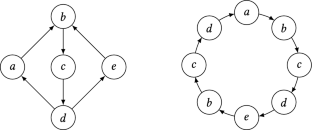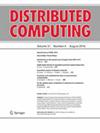全缺陷网络中的分布式计算
IF 1.3
4区 计算机科学
Q3 COMPUTER SCIENCE, THEORY & METHODS
引用次数: 0
摘要
我们解决了完全有缺陷的异步网络,其中所有链接都受到无限数量的更改错误的影响,这意味着网络中的所有消息都可能完全损坏。尽管可能直观地认为这种设置对于任何可靠的通信都过于苛刻,但我们展示了如何在任何完全有缺陷的设置上模拟无噪声设置的任何算法,假设网络是2边连接的。我们证明了如果网络不是2边连接的,在完全缺陷设置下不可能进行非平凡计算。我们利用的2边连通图的关键结构属性是存在一个经过所有节点的有向(非简单)循环(Robbins, Am。数学。星期一,1939)。我们技术贡献的核心是在完全有缺陷的网络中构造这样一个罗宾斯循环,并展示如何在完全消息损坏的情况下通过它进行通信。这些都是以内容无关的方式获得的,因为节点必须忽略接收到的消息的内容。本文章由计算机程序翻译,如有差异,请以英文原文为准。

Distributed computations in fully-defective networks
We address fully-defective asynchronous networks, in which all links are subject to an unlimited number of alteration errors, implying that all messages in the network may be completely corrupted. Despite the possible intuition that such a setting is too harsh for any reliable communication, we show how to simulate any algorithm for a noiseless setting over any fully-defective setting, given that the network is 2-edge connected. We prove that if the network is not 2-edge connected, no non-trivial computation in the fully-defective setting is possible. The key structural property of 2-edge-connected graphs that we leverage is the existence of an oriented (non-simple) cycle that goes through all nodes (Robbins, Am. Math. Mon., 1939). The core of our technical contribution is presenting a construction of such a Robbins cycle in fully-defective networks, and showing how to communicate over it despite total message corruption. These are obtained in a content-oblivious manner, since nodes must ignore the content of received messages.
求助全文
通过发布文献求助,成功后即可免费获取论文全文。
去求助
来源期刊

Distributed Computing
工程技术-计算机:理论方法
CiteScore
3.20
自引率
0.00%
发文量
24
审稿时长
>12 weeks
期刊介绍:
The international journal Distributed Computing provides a forum for original and significant contributions to the theory, design, specification and implementation of distributed systems.
Topics covered by the journal include but are not limited to:
design and analysis of distributed algorithms;
multiprocessor and multi-core architectures and algorithms;
synchronization protocols and concurrent programming;
distributed operating systems and middleware;
fault-tolerance, reliability and availability;
architectures and protocols for communication networks and peer-to-peer systems;
security in distributed computing, cryptographic protocols;
mobile, sensor, and ad hoc networks;
internet applications;
concurrency theory;
specification, semantics, verification, and testing of distributed systems.
In general, only original papers will be considered. By virtue of submitting a manuscript to the journal, the authors attest that it has not been published or submitted simultaneously for publication elsewhere. However, papers previously presented in conference proceedings may be submitted in enhanced form. If a paper has appeared previously, in any form, the authors must clearly indicate this and provide an account of the differences between the previously appeared form and the submission.
 求助内容:
求助内容: 应助结果提醒方式:
应助结果提醒方式:


